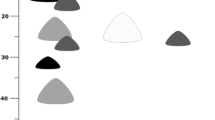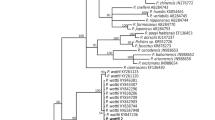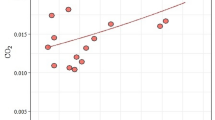Summary
-
1.
Colonies of Polistes canadensis canadensis (L.) in the lower Amazon region of Brazil are founded by 2–29 females (average: 9.1). Subsequent combs are added around the first at a rate correlated with number of foundresses and with the overall rate of new cell construction. Combs grow for an average of 15.4 days and achieve an average size of 30.8 cells. As older combs are abandoned, brood rearing moves into new combs. A large, mature but still growing colony had 838 cells distributed among 38 combs.
-
2.
It is estimated that the cost to the average P. canadensis colony of constructing multiple combs is 12% of its nest construction budget, and that failure to reutilize cells for a second batch of brood may cost an additional 100%.
-
3.
The most common pest of P. canadensis colonies is a tineid moth belonging to an undescribed genus. Its larvae, present in 56% of the colonies surveyed, primarily scavenge on meconia in the nest, but can burrow from cell to cell and on occasion prey on wasp pupae.
-
4.
It is hypothesized that several peculiar behaviors exhibited by the wasp, including multiple comb building, are adaptations that reduce brood loss to these moths. Since a comb cannot be invaded by moths until a meconium is exposed by the production of the first adult, dividing the brood into many small isolated batches of short age range reduces the risk that a given pupa will be attacked by moth larvae. It also reduces the risk that brood will be lost due to the nest-weakening effects of moth infestation. Colonies infested by the moth did not use their combs to rear a second batch of brood, while uninfested colonies did. This may be an adaptation to counter the much greater risk to the second batch of brood of loss to moth infestation. Chewing down cell walls and the removal of whole combs by a colony may also be directed toward reducing the impact of the moths on colony success.
Similar content being viewed by others
References
Ballou, H.A.: West Indian wasps. Agr. News (Barbados) 14, 298 (1915)
Evans, H.E., West Eberhard, M.J.: The wasps. Ann Arbor, Michigan: The University of Michigan Press 1970
Jeanne, R.L.: The adaptiveness of social wasp nest architecture. Q. Rev. Biol. 50, 267–287 (1975)
Nelson, J.M.: Parasites and symbionts of nests of Polistes wasps. Ann. Entomol. Soc. Am. 61, 1528–1539 (1968)
Rau, P.: The jungle bees and wasps of Barro Colorado Island (with notes on other insects). Kirkwood, Missouri: Phil Rau 1933
Rau, P.: Observations on certain lepidopterous and hymenopterous parasites of Polistes wasps. Ann. Entomol. Soc. Am. 34, 355–366 (1941)
Richards, O.W.: The social wasps of the Americas excluding the Vespinae. London: British Museum (Natural History) 1978
Richards, O.W., Richards, M.J.: Observations on the social wasps of South America (Hymenoptera, Vespidae). Trans. R. Entomol. Soc. London 102, 1–170 (1950)
Rodriques, V.M.: Estudo sôbre vespas sociais do Brasil (Hymenoptera-Vespidae). D.Sc. Thesis, Faculdade de Filosofia, Ciências e Letras de Rio Claro, Universidade de Campinas (1968)
Vesey-Fitzgerald, D.: Social wasps (Hym. Vesipdae) from Trinidad, with a note on the genus Trypoxylon Latreille. Trans. R. Entomol. Soc. London 87, 181–191 (1938)
West Eberhard, M.J.: The social biology of polistine wasps. Misc. Publ. Mus. Zool. Univ. Mich. 140, 1–101 (1969)
West Eberhard, M.J.: Estudios de las avispas sociales (Himenoptera, Vespidae), del Valle del Cauca. I. Objectivos, metodos, y notas para facilitar la identificacion de especies communes. Cespedesia 4, 245–267 (1975)
Wilson, E.O.: The insect societies. Cambridge, Massachusetts: Belknap Press of Harvard University Press 1971
Author information
Authors and Affiliations
Rights and permissions
About this article
Cite this article
Jeanne, R.L. Construction and utilization of multiple combs in Polistes canadensis in relation to the biology of a predaceous moth. Behav Ecol Sociobiol 4, 293–310 (1979). https://doi.org/10.1007/BF00297649
Received:
Issue Date:
DOI: https://doi.org/10.1007/BF00297649




